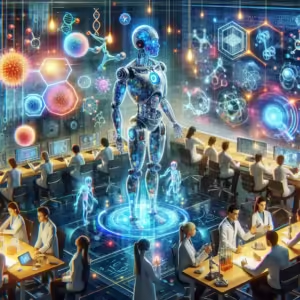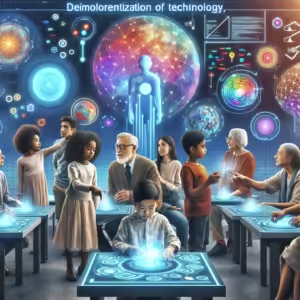Unleashing the Power of AI in Audio Engineering
The soundscape of the digital world is undergoing a transformation, propelled by cutting-edge technology and artificial intelligence. The latest leap comes from Nvidia, a leader in AI and graphics processing, which has stunned audiences with its groundbreaking audio generator capable of producing sounds as unconventional and imaginative as a saxophone barking like a dog. This innovation not only revolutionizes sound creation but also opens up new avenues for musicians, sound designers, and creative professionals worldwide.
What is Nvidia’s AI Audio Generator?
Nvidia, renowned for its advancements in GPU technology, has expanded its horizons into the realm of audio processing. Their new AI audio generator leverages deep learning algorithms to mimic, adapt, and create unique soundscapes. Unlike traditional sound synthesis tools, this generator uses an immense database of audio samples and sophisticated AI to produce high-quality, realistic, and entirely novel sound effects.
Key Features that Stand Out
Nvidia’s AI Audio Generator sets itself apart with several standout features:
- Versatility: Capable of generating a wide range of sounds, from the conventional to the fantastical.
- Realism: Produces high-fidelity audio that can mimic real-world sounds with uncanny accuracy.
- Customizability: Allows users to tweak acoustic parameters for personalized audio experiences.
- Efficiency: Delivers complex sound generation swiftly, thanks to Nvidia’s cutting-edge processing units.
How Does It Work?
Nvidia’s AI audio generator is powered by a combination of machine learning algorithms and its proprietary deep learning architecture. At its core, the technology builds on Generative Adversarial Networks (GANs), which pit two neural networks against each other to refine outputs continuously. This approach ensures that the generated sounds evolve and improve over time, mimicking real-world acoustics while allowing for creativity and divergence from established norms.
The Training Process
The AI system is trained on a vast library of sounds, including musical instruments, environmental noises, and abstract tones. As it processes these sounds, it learns to understand the complex patterns and nuances that make each audio clip unique. This training process involves:
- Data Collection: Amassing a diverse range of audio samples.
- Feature Extraction: Identifying key characteristics and acoustical features of each sample.
- Model Training: Utilizing advanced neural networks to learn from the extracted features.
By iterating through this process, the AI becomes adept at generating audio that is both distinctive and realistic.
Applications of AI-Driven Audio Generation
The potential applications for Nvidia’s AI audio generator extend far beyond mere novelty, offering practical and revolutionary impacts across various fields.
Music and Entertainment
In the realm of music production, this technology allows composers to experiment with wholly new sound palettes, effectively breaking the barriers of traditional genres. Musicians can blend synthetic and natural sounds effortlessly, creating sonics never heard before. Additionally, video game and film industries can benefit from this technology to produce immersive soundtracks and sound effects that enhance storytelling.
Virtual Reality and Augmented Reality
As VR and AR technologies advance, the demand for more engaging auditory experiences grows. Nvidia’s audio generator offers a solution by providing realistic and context-aware soundscapes that enhance user immersion. Imagine exploring a virtual jungle where the wind whispers through the trees, or a bustling cityscape where the distant chatter and traffic noise react dynamically to your movements.
Assistive Technologies
For individuals with hearing impairments, AI-driven audio technologies can create enhanced auditory environments. By adjusting sound frequencies and volume levels in real-time, assistive devices can tailor audio to the user’s specific needs, improving the clarity and comprehensibility of speech and other important sounds.
The Future of Sound Innovation
Nvidia’s latest development is a testament to the limitless possibilities that AI brings to the table in the field of audio engineering. As these technologies continue to mature, we anticipate further breakthroughs that will redefine how we produce and experience sound.
The Role of AI in Shaping the Audio Landscape
AI is poised to become an indispensable tool in audio production, allowing creators to push the boundaries of what’s possible. Its capability to analyze and generate sounds mimicking how humans perceive them opens up new dimensions for artistic expression and auditory experiences.
Challenges and Considerations
While Nvidia’s AI audio generator is a breakthrough, it also prompts ethical and philosophical questions about authenticity in art. As machines become adept at producing art previously considered uniquely human, it challenges our understanding of creativity and originality.
Creating a Balance
As we harness the power of AI in audio production, it’s crucial to maintain a balance between technological advancement and artistic integrity. While AI can enhance creativity, it should work alongside human ingenuity rather than replace it entirely.
Conclusion: Embracing the Sonic Future
Nvidia’s AI audio generator exemplifies the bold strides technology is making in reimagining sound. By transcending traditional audio limitations, it offers groundbreaking potential for music, entertainment, assistive technology, and beyond. As we continue to explore the intersection of creativity and technology, Nvidia’s innovation serves as a catalyst for what’s possible in the realms of sound and music creation, inviting us all to listen in and imagine new acoustic worlds. In this evolving landscape, the future sounds more exciting than ever.








